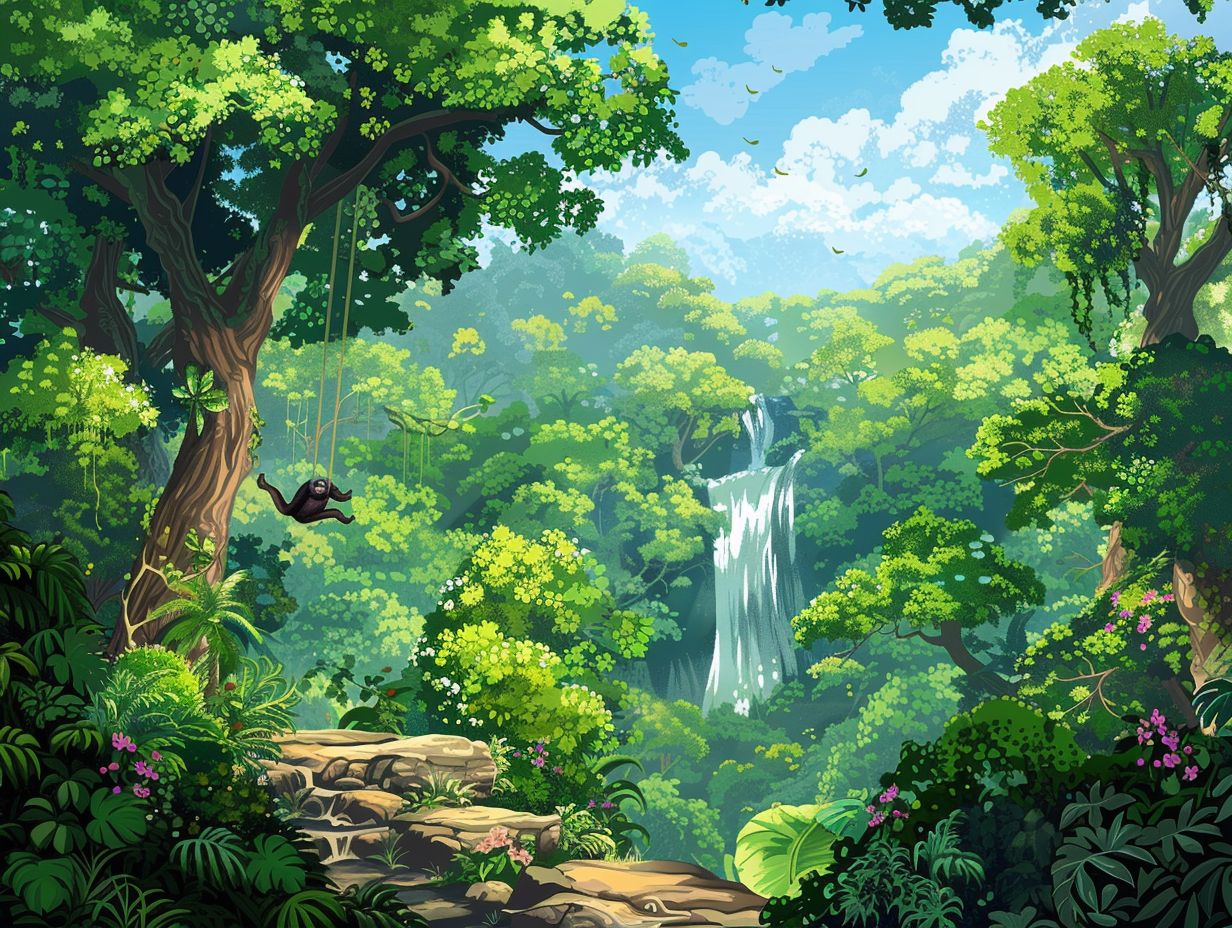
Gombe National Park
Gombe National Park, situated in Tanzania, is a captivating destination with a rich history and diverse wildlife.
We explore the park’s location and geography, its history, the wildlife it hosts, available tourism activities, and conservation efforts to safeguard this precious ecosystem.
From the park’s topography to the challenges it encounters, this article offers crucial information about Gombe National Park.
Key Takeaways:

- Located in Tanzania, Gombe National Park has a diverse topography of forests, grasslands, and water bodies.
- The park was named after the Gombe Stream, and used to be a hunting ground before being declared a national park in 1968.
- Gombe National Park is home to a variety of animals and over 200 bird species, including a large population of primates such as chimpanzees.
Location and Geography
Gombe Stream National Park is a renowned National Park located in Tanzania along the shores of Lake Tanganyika.
Located in the Kigoma District of Tanzania, Gombe Stream National Park boasts a unique setting near the shores of Lake Tanganyika, the second-oldest and second-deepest freshwater lake in the world.
The park’s position next to this massive body of water contributes to its rich biodiversity and distinct ecosystems.
Within the park, visitors can explore various habitats, from dense forests that are home to chimpanzees, to rolling mountains offering stunning panoramic views.
These diverse landscapes make Gombe Stream National Park a must-visit destination for nature enthusiasts and wildlife lovers.
Where is Gombe National Park Located?
Gombe National Park is situated in the beautiful country of Tanzania, specifically in the Kigoma District along the picturesque shores of Lake Tanganyika.
Surrounded by lush greenery and the gentle lapping of the lake’s waters, Gombe National Park is a haven for primates, notably known for its chimpanzee populations.
The park’s proximity to the Mahale Mountains National Park adds to its allure, creating a rich landscape for nature enthusiasts to explore.
Visitors can witness the convergence of thick forests, rolling hills, and the crystal-clear waters of Lake Tanganyika, providing a harmonious blend of terrains.
What is the Topography of Gombe National Park?
Gombe National Park boasts a varied topography that includes dense forests, towering mountains, and expansive savannas.
This diverse landscape provides a rich habitat for a wide range of wildlife, making it a prime location for nature lovers and researchers alike.
Located along the eastern shore of Lake Tanganyika in Tanzania, the park’s elevation ranges from 772 meters at the lakeshore to 1,500 meters at the peaks of the mountains.
This elevation gradient results in a diverse array of habitats, from the low-lying tropical forests to the montane forests at higher altitudes.
- The dense forests are home to chimpanzees, which the park is famous for, along with colobus monkeys, baboons, and a variety of bird species.
- The mountains provide a stunning backdrop and support populations of other primates such as red-tailed and vervet monkeys.
- The savannas within the park harbor grazing mammals like bushbucks, giraffes, and various antelope species, creating a dynamic and interconnected ecosystem.
History of Gombe National Park
The history of Gombe National Park is deeply intertwined with the pioneering work of renowned primatologist Jane Goodall, who conducted groundbreaking research on chimpanzees.
This research led to the establishment of the Gombe Stream Research Centre and laid the foundation for park protection and conservation efforts.
Jane Goodall’s immersive study of chimpanzee behavior in Gombe National Park brought international attention to the importance of conservation and research in the wild.
Her meticulous observations and groundbreaking discoveries have inspired generations of conservationists and researchers.
The establishment of the Gombe Stream Research Centre in 1965 marked a significant milestone in the efforts to protect the park’s unique ecosystem.
Over the years, various conservation initiatives have been introduced to safeguard the biodiversity and ecological balance of this vital habitat.
Efforts have also been made to promote sustainable tourism providing visitors with a chance to appreciate the beauty of nature while supporting the park’s conservation goals.
How Did Gombe National Park Get Its Name?
Gombe National Park derived its name from the picturesque Gombe Stream that flows through the park, enriching its ecosystem and providing a vital water source for the diverse wildlife.
The name reflects the park’s essence and the significance of the stream in supporting its biodiversity.
The Gombe Stream, which meanders through the park’s lush surroundings, serves as a lifeline for the countless species that call this natural haven home.
Gombe National Park’s name encapsulates this intricate relationship between the flowing waters of the Gombe Stream and the life it sustains.
What Was the Park Used for Before It Became a National Park?

Before attaining its status as a National Park, Gombe Stream was a haven for diverse wildlife and played a crucial role in conservation efforts.
The lush forests and abundant biodiversity of the region made it a prime location for research and preservation, laying the groundwork for its eventual designation as a protected area.
In the pre-national park era, Gombe Stream’s landscape buzzed with a plethora of animal species coexisting harmoniously in its rich ecosystem.
Researchers, drawn to the area’s unspoiled beauty, embarked on groundbreaking studies that unraveled the complexities of primate behavior, particularly in chimpanzees.
This research not only illuminated the fascinating social dynamics of these primates but also underscored the importance of preserving their habitat.
The findings paved the way for broader conservation initiatives aimed at safeguarding not just the chimps but the entire web of life that thrived in this verdant sanctuary.
Wildlife in Gombe National Park
Gombe National Park is home to a diverse array of wildlife, including iconic chimpanzees that have been studied extensively by researchers like Jane Goodall.
The park’s lush forests, picturesque valleys, and vibrant savannas provide habitats for various species of birds and primates, showcasing the rich biodiversity of the region.
Among the other primates that call Gombe National Park their home are baboons, colobus monkeys, and red-tailed monkeys, each adapting uniquely to the different habitats within the park.
The park’s avian population is equally impressive, with over 200 species of birds soaring through the treetops and filling the air with melodic calls.
Conservation efforts within the park are crucial to preserving this delicate ecosystem and ensuring the continued survival of these diverse species.
What Animals Can Be Found in Gombe National Park?
Gombe National Park is teeming with a variety of wildlife, with a special focus on its chimpanzee population that has garnered international attention.
Plus the primates, the park is home to a diverse array of animals, including various species of birds, making it a paradise for nature enthusiasts and researchers.
The park’s lush forests provide a haven for other primate species such as olive baboons, red colobus monkeys, and vervet monkeys, each playing a crucial role in the park’s ecosystem.
The rich avian fauna includes colorful species like the African fish eagle, palm-nut vulture, and African grey parrot, adding a vibrant touch to the park’s natural beauty.
Observing these animals in their natural habitats offers a unique opportunity to witness the intricate interactions and behaviors that shape the wildlife landscape of Gombe National Park.
What Birds Can Be Found in Gombe National Park?
The lush forests, picturesque valleys, and dense jungles provide ideal conditions for a wide range of bird species, making birdwatching a popular activity for visitors exploring the park.
Among the feathered residents of Gombe National Park, one can spot the colorful Fischer’s Lovebirds flitting among the trees, their vibrant plumage contrasting beautifully with the green foliage.
The melodious calls of the African Pied Wagtails echo through the valleys while the Black-casqued Wattled Hornbills soar gracefully overhead with their distinctive beak.
The park also hosts the charming Palm-nut Vultures, often seen majestically circling the skies in search of prey, showcasing the intricate dynamics of the park’s ecosystem.
What is the Primate Population in Gombe National Park?
Gombe National Park is renowned for its significant primate population, particularly the chimpanzees that have been extensively studied for their social behaviors and interactions.
The presence of various primate species in the park’s diverse forest habitats offers researchers a unique opportunity to observe and understand primate behavior in their natural environment.
Chimpanzees in Gombe National Park showcase complex social structures, exhibiting behaviors such as tool use, hunting, and communication through gestures and vocalizations.
Besides chimpanzees, the park hosts baboons, colobus monkeys, and vervet monkeys, each contributing to the rich primate diversity.
Studying these primates provides insights into evolutionary history and aids in the conservation of the park’s ecosystem by identifying key species interactions and habitat requirements.
The ongoing research in the park underscores the importance of primate conservation for biodiversity preservation.
Tourism in Gombe National Park
Tourism in Gombe National Park offers visitors a unique opportunity to explore, with activities such as trekking, admiring majestic mountains, and experiencing firsthand the conservation efforts.
Embarking on a trekking adventure in this park allows you to immerse yourself in the rich biodiversity while being surrounded by the soothing sounds of nature.
As you navigate through the dense forests, you may encounter a variety of indigenous flora and fauna unique to this region, creating unforgettable memories.
The forest exploration in Gombe National Park unveils hidden gems at every turn, from vibrant bird species to elusive primates like chimpanzees.
The park’s breathtaking mountain vistas provide a picturesque backdrop that showcases the park’s diverse topography, inviting visitors to enjoy awe-inspiring views.
What Activities Can Visitors Do in Gombe National Park?

Visitors to Gombe National Park can partake in a range of activities, from adventurous treks through dense forests to immersive wildlife encounters that showcase the park’s rich biodiversity.
The conservation-focused experiences allow visitors to engage with the park’s mission of preserving its natural habitats and wildlife.
One of the main draws for visitors is the opportunity to embark on guided treks led by knowledgeable park rangers, who provide insights into the local flora and fauna.
These treks can vary from gentle walks to more challenging hikes, catering to diverse interests and fitness levels.
For those fascinated by primates, Gombe National Park offers a chance to observe chimpanzees in their natural habitat, providing a rare and intimate window into their social interactions and behaviors.
The park’s visitor centers and educational programs offer valuable information on conservation practices, highlighting the importance of sustainable tourism and environmental stewardship in the region.
What Are the Accommodation Options in Gombe National Park?
Accommodation options in Gombe National Park cater to a range of preferences, from comfortable lodges to immersive camping experiences.
These lodging choices offer a blend of comfort and adventure for guests seeking a memorable stay.
For those looking for a truly unique experience, the park also offers wildlife-centric stays where visitors can witness the daily rhythms of the animals up close.
These accommodations often provide guided safaris and nature walks, giving guests a deeper insight into the diverse flora and fauna of Gombe National Park.
Some lodges boast stunning views of Lake Tanganyika, adding a picturesque element to the already captivating environment.
What is the Best Time to Visit Gombe National Park?
The best time to visit Gombe National Park is during the dry season, typically from June to October, when wildlife sightings are at their peak, and trekking conditions are optimal.
This period offers visitors a chance to witness the park’s abundant wildlife, vibrant birdlife, and conservation efforts in full swing.
The dry season in Gombe National Park provides a unique opportunity for wildlife enthusiasts to observe the interactions between chimpanzee families.
The reduced vegetation during this time enhances visibility, making it easier to spot other iconic species such as baboons, red-tailed monkeys, and the elusive colobus monkeys.
Birdwatching enthusiasts will be delighted by the diverse avian species that thrive in the park, including African fish eagles, palm-nut vultures, and various colorful sunbirds.
The clear skies and moderate temperatures during the dry season create perfect conditions for uninterrupted birdwatching experiences.
Visitors during the dry season also have the chance to witness the dedicated conservation efforts taking place in Gombe National Park.
Rangers actively monitor wildlife, conduct research studies, and engage in community outreach programs to ensure the long-term sustainability of the park’s ecosystem.
What Are the Entrance Fees for Gombe National Park?
The entrance fees for Gombe National Park contribute to its conservation efforts and the preservation of its rich biodiversity.
These fees support the park’s maintenance, wildlife protection initiatives, and conservation projects that ensure the sustainability of its natural resources for future generations.
Visitors to Gombe National Park are not just paying an entrance fee; they are actively participating in the preservation of a crucial ecosystem.
The revenue generated from these fees plays a vital role in funding anti-poaching patrols, habitat restoration programs, and community engagement projects.
It enables ongoing research on endangered species, education programs, and the development of sustainable tourism practices, creating a positive cycle of conservation and visitor engagement.
Conservation Efforts in Gombe National Park
Conservation efforts in Gombe National Park are crucial for protecting its diverse wildlife, preserving habitats, and combatting threats such as habitat loss and human-wildlife conflict.
Through ongoing research efforts, scientists have been able to gain valuable insights into the behavior patterns of the park’s inhabitants, which in turn guide the implementation of conservation.
By working closely with local communities, the authorities have succeeded in raising awareness about the importance of wildlife preservation and fostering a culture of coexistence.
What Threats Does Gombe National Park Face?
Gombe National Park faces various threats, including habitat destruction, poaching, and human encroachment, which pose significant challenges to the park’s conservation efforts.
These threats endanger the wildlife, disrupt ecosystems, and necessitate proactive measures to safeguard the park’s biodiversity and ecological balance.
One of the primary threats to Gombe National Park is habitat destruction, which occurs mainly due to deforestation, agricultural expansion, and infrastructure development.
Deforestation leads to loss of critical habitats for various species, affecting their population and diversity.
Poaching activities targeting endangered animals such as chimpanzees further exacerbate the situation, disrupting the delicate ecological balance within the park.
Human-wildlife conflicts also arise as local communities struggle to coexist with wildlife, leading to retaliatory killings and habitat fragmentation.
Conservation strategies such as creating protected areas, implementing community-based conservation initiatives, and promoting sustainable practices which are crucial .
What Conservation Efforts Are Being Made to Protect the Park?

To protect Gombe National Park, conservation efforts focus on habitat restoration, anti-poaching measures, community education, and sustainable tourism practices.
By engaging local communities, implementing park protection strategies, and promoting responsible tourism, the authorities aim to safeguard biodiversity and create a harmonious coexistence.
One of the key strategies for habitat restoration in Gombe National Park is the replanting of native vegetation to provide food and shelter for its wildlife inhabitants.
Through collaborative efforts with local communities, degraded areas are being rehabilitated, ensuring that the park’s ecosystems remain healthy and diverse.
In terms of anti-poaching activities, rigorous monitoring systems and patrols have been put in place to combat illegal hunting and protect the park’s wildlife from poachers.
Community enablement programs equip locals with sustainable livelihood options, reducing their reliance on activities that harm the park’s flora and fauna.
Sustainable tourism initiatives within the park not only generate revenue for conservation efforts but also raise awareness about the importance of preserving natural habitats.
By offering eco-friendly accommodations and promoting guided tours that prioritize wildlife protection, Gombe National Park strives to balance visitor experiences with environmental conservation.
Frequently Asked Questions
1. What is Gombe National Park?
A: Gombe National Park is a national park located in western Tanzania, known for its population of chimpanzees and being the site of Jane Goodall’s groundbreaking research on these primates.
2. How big is Gombe National Park?
A: Gombe National Park covers an area of 52 square kilometers, or 20 square miles, and is situated on the eastern shore of Lake Tanganyika.
3. What makes Gombe National Park unique?
A: Gombe National Park is unique for its focus on the protection and conservation of chimpanzees, as well as its location on the shores of Lake Tanganyika, one of the oldest and deepest lakes in the world.
4. What activities can I do at Gombe National Park?
A: Visitors to Gombe National Park can go on guided chimpanzee trekking tours, take boat trips on Lake Tanganyika, hike to beautiful waterfalls, and even snorkel in the crystal clear waters of the lake.
5. When is the best time to visit Gombe National Park?
A: The dry season, from June to October, is generally considered the best time to visit Gombe National Park. During this time, the weather is cooler and drier, making it easier to spot chimpanzees and engage in outdoor activities.
6. Do I need a permit to visit Gombe National Park?
A: Yes, all visitors to Gombe National Park are required to obtain a permit. These can be obtained through the Tanzania National Parks Authority or from registered tour operators. The permit fees help fund conservation efforts in the park.